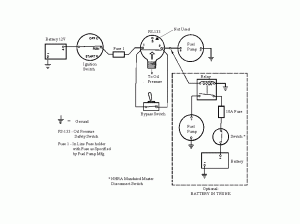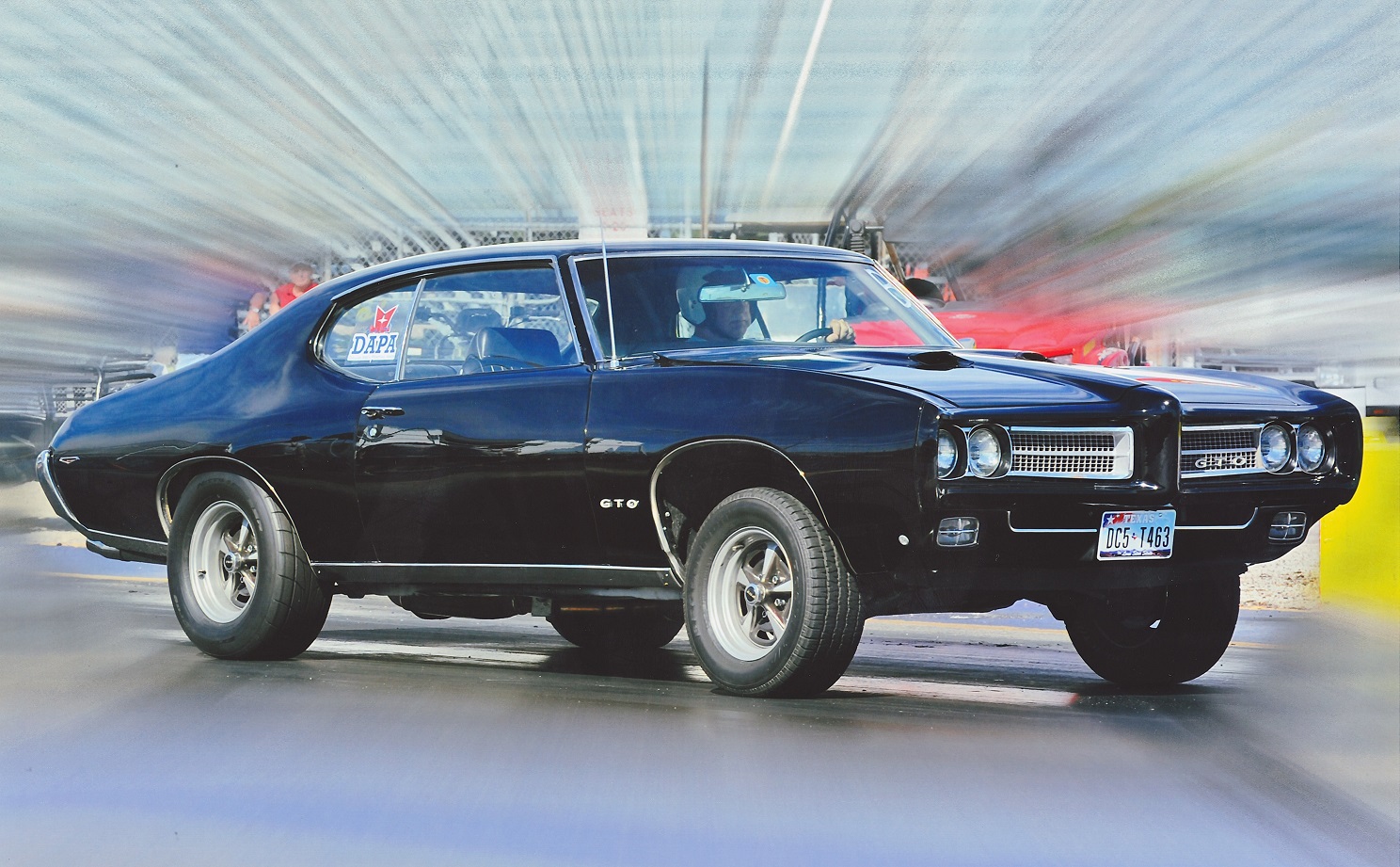Drag Racing with Jim Hand – Part 15: Electric Fuel Pump Safety
- March 16th, 2010
- Posted in Jim Hand: Drag Racing . Technical Articles
- By D.A.P.A
- Write comment
You may remember the letter from John Mino that was published in this column in 1996. John described his good experience when he switched to race fuel in his Pontiac at the drag strip, and suggested we try it in our ’71 LeMans wagon.
In order to provide an accurate test it was deemed necessary to make several runs with the Amoco “Clear” 92 octane pump gas that we normally use, and then drain the tank and add the race fuel. Several runs would then be made with no other changes except the switch to race fuel. Further, we wanted to run on a well prepared track in order to minimize changes caused by possible traction problems.
In early September, a Street Machine race was conducted at our local track during the day. After the track surface was prepared, we made two runs with the 92 octane gas. The tank was then pumped dry (more on this later), and five gallons of fresh Sunoco “Supreme” 115 octane race fuel was added. Five full throttle runs were made with the race fuel prior to eliminations, with several minor jetting changes (after two runs) in order to assure that jetting was satisfactory for the new fuel. We did not change the normal timing of 32 degrees total (that has proven to be optimum for our normal fuel), due to time limitations. Our experience with the race fuel did not reflect the significant performance gains found by John Mino:
- Average of two runs with 92 octane pump gas; 12.300 at 111.00, with 60′ time of 1.867, and a best run of 12.297 at 111.06.
- Average of five runs with 115 octane race fuel; 12.301 at 111.34, with 60′ time of 1.853, and a best run of 12.259 at 111.88.
The slight increase of top speed could be attributable to the fuel, but could also be a result of a minor wind shift during the test period. A definite rougher idle was noted with the fuel, as well as tendency for slightly harder starting. We would like to have changed the timing during the testing, but simply did not have enough runs to do so. Why so much difference between our test and John’s? Each engine/vehicle combination is unique, and the load the engine sees throughout the normal RPM is dependent on tire size, converter type gears, weight, etc. The state of tune of the engine for the fuel normally used, and for the new fuel could have an effect. The quality of the fuel normally used, and the BTU content of the new fuel must be considered. Note that race gas does not have a greater BTU (energy) content than pure pump gas, but rather has a unique combination of additives to increase the octane rating. The additional octane allows a higher compression engine to be tuned optimally for the characteristics of that specific engine, and thus may produce greater power via the higher compression. If you decide to run race fuel regularity, it is essential that your engine be correctly tuned for the new fuel, both in fuel mixture, and correct timing, in order to realize any advantages. You racers that already use race fuel may want to re-test the tuning of your combination to assure that your intake and ignition systems are properly set for the fuel you are now using. A change in brand or octane, or seemingly minor engine modifications could have a significant effect. Additionally, street gas with alcohol added to increase the octane rating can prevent a serious problem of tuning. Alcohol has about half the BTU content of gas per gallon, and although the octane may be adequately high for your engine, you may have to run a richer fuel mixture for optimum performance with the “gasohol.”
John, I probably should have tried the Sunoco “Standard” 100 octane fuel, but fell prey to the old myth that “bigger has to be better.” Not all was lost however, as I won the DOT tire and muffler bracket race with the fuel. Again, thanks for sharing your experiences with us.
We mentioned pumping fuel from the tank. We run an electric fuel pump for fuel delivery on the wagon. An oil pressure safety switch is installed in the power circuit to the pump. Thus, the pump will not normally operate unless the engine is running and generating oil pressure. The oil pressure safety switch should be considered mandatory with any electric fuel pump installation, in order to provide an automatic kill of the fuel pump in an accident. If the pump is powered directly through the ignition switch, the pump will operate any time the ignition switch is “on.” In case the driver is disabled during an accident and cannot shut off the ignition, the pump will continue to operate, and if there is fire, it will be much more serious due to the continuing supply of gas to the engine compartment. However, safety comes at a price. The safety switch makes it almost impossible to fill the carb after it is empty (after carb service, leakage, initial setup, etc.), and thus makes it very difficult to start the engine without excessive cranking. Most safety switches have a “start” terminal, but the “start” wiring on Pontiacs vary widely, and it is very complicated to wire a satisfactory start circuit for an electric pump. We elected to install a “Momentary On” override switch in parallel with the oil pressure safety switch such that with the ignition switch set to “run” position, we can hold the override switch on and activate the electric fuel pump. When the override switch is released the system reverts back to full control of the safety switch and it’s inherent safety protection. The override circuit allows carb priming, capability to check electric pump action and fuel delivery, and in our case, to completely and quickly empty the tank in the wagon. (I have installed a bottom fuel outlet in the fender mounted vertical fuel tank in the wagon.)
Oil pressure safety switches are available from many after-market suppliers, but also can be obtained at a reasonable price from your local auto parts dealer under the “Standard” brand PN PS-133, or any equivalent switch for a Chevy Vega. The bypass switch is a conventional bat handled toggle switch in an “off-momentary ON, single pole, single throw” configuration. Most larger hardware stores have these, or you can obtain them through “Grainger” PN 4X200, “Carling switch” PN 6FA54-73, “Arrow Hart” PN 82270, “Cutler Hammer” PN 7506K4, or “McGill” PN 933002. Mount the switch in an “out of the way” but convenient to reach location, such as under the instrument panel to the left of the steering column.
If your existing electric pump varies speed when some accessories are switched on, such as when the blinker or turn lights are on, it indicates that inadequate power is reaching the fuel pump, and could be due to inadequate wire size, poor connections, or a faulty ground connection at the pump. If your battery is mounted in the trunk, an easy fix for low voltage at the pump is to install a relay such as is used for auxiliary lighting (10 amp or greater capacity) in the rear and activate it by the existing power wire to the pump. We use a “Blazer” brand 30 amp relay purchased from K-Mart Automotive. Install 12 gauge wire from the “normally open” relay switch contacts to both the battery (through the NHRA required master disconnect switch) and the pump positive terminal. Reroute the control wire for the pump positive terminal to the relay coil “+” terminal. Install an inline 10 amp fuse close to the battery. The electric pump will run at a constant speed, and operate more efficiently when loaded at high RPM due to the direct wiring with minimum voltage loss, plus the above described safety circuits will continue to function as described.
Reference the drawing for suggested wiring of a safety switch, and the bypass (priming) switch. Note that the specified fuel pump fuse (normally 7 amp but 10 can be used) should be located in the engine compartment and be connected between the 12V power source and the safety switch. Be extremely thorough with all wiring and assure good solid crimped or soldered joints and connections, and add adequate insulation to all connections. Never trust a twisted wire connection for anything as important as an electric pump.


